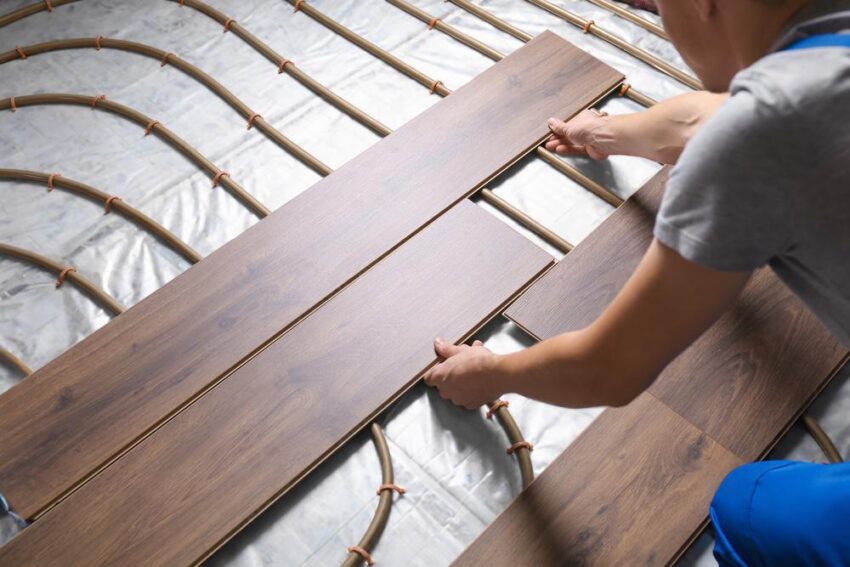Table of Contents
Laminate flooring has become a popular choice for homeowners due to its durability, affordability, and elegant appearance. Whether you are a DIY enthusiast or hiring professionals, ensuring a flawless laminate floor installation requires careful planning and attention to detail. This comprehensive checklist will guide you through every step, ensuring your laminate flooring project is executed perfectly.
Key Takeaways
- Proper Preparation: Ensure accurate measurements, a clean subfloor, and acclimate planks for a successful installation.
- Essential Tools and Materials: Gather all necessary tools to streamline the installation process.
- Professional Finish: Use spacers, stagger joints, and add transition strips for a polished look.
- Maintenance Tips: Regular cleaning and protective measures extend the floor’s lifespan.
- Common Pitfalls: Avoid mistakes like inadequate expansion gaps and improper plank alignment.
Why Choose Laminate Flooring?
Laminate flooring is an excellent option for those looking to balance style, durability, and budget. It is designed to mimic the look of hardwood, stone, or tile while offering superior resistance to scratches, stains, and fading. Additionally, laminate flooring is easy to clean and maintain, making it ideal for high-traffic areas such as living rooms, kitchens, and hallways.
Preparing for Installation
Proper preparation is crucial for a successful laminate floor installation. Begin by measuring the area where you plan to install the flooring. Accurate measurements will help you calculate the amount of laminate needed, including extra pieces for cuts and potential mistakes. It is recommended to purchase 10% more than the required area to account for waste.
Ensure that the subfloor is clean, dry, and level. Uneven subfloors can cause the laminate planks to shift, resulting in gaps and creaking noises. If necessary, use a leveling compound to even out any irregularities. Additionally, allow the laminate flooring to acclimate to the room’s temperature and humidity for at least 48 hours before installation. This prevents expansion or contraction after installation.
Tools and Materials Checklist
To streamline the installation process, gather the following tools and materials:
- Laminate flooring planks
- Underlayment (if required)
- Measuring tape
- Utility knife
- Spacers
- Pry bar
- Rubber mallet
- Tapping block
- Saw (miter saw or jigsaw)
- Transition strips
- Adhesive (if needed)
- Safety gear (gloves, safety glasses)
Having the right tools on hand ensures that the installation proceeds smoothly and efficiently.
Installing the Underlayment
Underlayment is essential for laminate floor installation, as it provides cushioning, reduces noise, and acts as a moisture barrier. Begin by laying the underlayment perpendicular to the direction of the laminate planks. Ensure there are no gaps or overlapping edges. Secure the underlayment with tape to keep it in place during installation.
Planning the Layout
Before laying the first plank, determine the direction in which you want the laminate flooring to run. Typically, it is recommended to lay the planks parallel to the longest wall or in the direction of the main light source for a more spacious appearance.
Dry-fit the first row without adhesive to ensure proper alignment. Use spacers to maintain an expansion gap of at least 1/4 inch around the room’s perimeter to allow for natural expansion and contraction.
Installing the Laminate Flooring
Start with the first row along the longest wall, placing spacers between the planks and the wall. Connect the planks by aligning the tongue and groove edges and gently tapping them into place using a tapping block and rubber mallet.
For the next row, stagger the joints by at least 12 inches to create a natural pattern and enhance stability. Continue connecting the planks row by row, ensuring a snug fit without gaps. Use a saw to cut the last plank of each row to fit.
Trimming and Finishing Touches
Once the laminate flooring is fully installed, remove the spacers and install baseboards or quarter-round moldings to cover the expansion gaps. Secure the moldings to the wall, not the floor, to allow the laminate to expand and contract freely.
Transition strips should be installed at doorways or where the laminate meets other flooring types. This provides a seamless transition and prevents tripping hazards.
Cleaning and Maintenance Tips
After installation, clean the laminate floor to remove dust and debris. Use a vacuum or a damp mop designed for laminate surfaces. Avoid excessive water and harsh cleaning agents, as they can damage the laminate’s protective layer.
Regular maintenance includes sweeping or vacuuming to prevent dirt and grit from scratching the surface. Place felt pads under furniture legs and use rugs in high-traffic areas to extend the floor’s lifespan.
Common Installation Mistakes to Avoid
To ensure a flawless installation, be mindful of the following common mistakes:
- Neglecting to acclimate the laminate planks
- Skipping the underlayment step
- Not leaving enough expansion gaps
- Misaligned planks or uneven cuts
- Using improper cleaning methods after installation
By avoiding these pitfalls, you can achieve a professional-looking laminate floor that lasts for years.
When to Call a Professional
While laminate floor installation can be a rewarding DIY project, some situations may require professional expertise. Consider hiring a professional if:
- The subfloor is severely uneven or damaged
- Complex room layouts with multiple transitions
- Limited time or lack of necessary tools
Professional installers have the skills and experience to handle challenging scenarios and ensure a flawless finish.
Final Inspection and Enjoyment
After completing the installation, perform a final inspection to check for any gaps, misaligned planks, or uneven edges. Ensure all moldings and transition strips are securely in place. Once satisfied with the results, your new laminate flooring is ready to be enjoyed.
A well-executed laminate floor installation enhances the beauty and functionality of your space. By following this comprehensive checklist, you can achieve a stunning and durable floor that elevates your home’s interior.
Troubleshooting Common Issues
During laminate floor installation, you may encounter challenges such as uneven seams, buckling, or squeaking noises. These issues often result from inadequate subfloor preparation, insufficient expansion gaps, or improper plank alignment. To resolve these problems, check the subfloor’s levelness, adjust the expansion gaps, and ensure each plank is securely connected. Regular inspections during installation can help prevent these issues from becoming significant problems later.
Enhancing Durability and Longevity
To maximize the lifespan of your laminate flooring, consider additional protective measures. Using moisture barriers in damp areas, applying furniture pads to prevent scratches, and maintaining consistent indoor humidity levels can significantly enhance the floor’s durability. Proper care and maintenance, such as routine cleaning and avoiding excessive water exposure, will keep your laminate flooring looking new for years to come.
Can laminate flooring be installed over existing flooring?
Yes, laminate flooring can be installed over existing flooring such as vinyl, tile, or hardwood, provided the surface is clean, dry, and level. However, avoid installing laminate over carpet or uneven surfaces, as this can cause buckling and instability. Using an appropriate underlayment ensures proper cushioning and moisture protection.
How long does laminate floor installation take?
The installation time for laminate flooring depends on the room size and complexity of the layout. For an average-sized room, it typically takes one to two days, including preparation and finishing touches. Proper planning, accurate measurements, and having the right tools can significantly reduce installation time.
Can laminate flooring be used in moisture-prone areas?
While standard laminate flooring is not waterproof, certain water-resistant or waterproof laminate options are suitable for moisture-prone areas like kitchens and bathrooms. Using a moisture barrier underlayment and sealing the edges with waterproof sealant can help protect the laminate from water damage.

